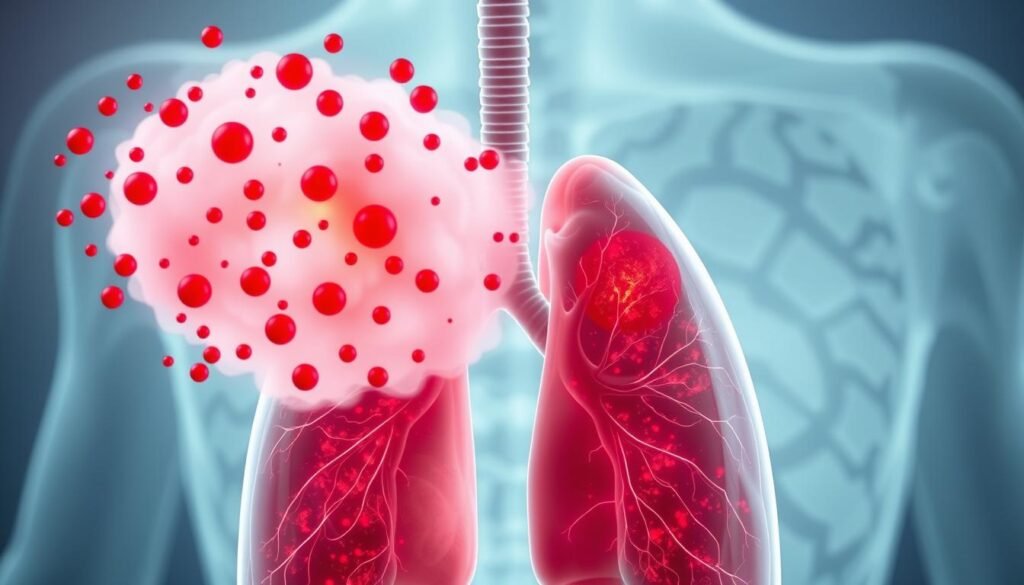Lung cancer is the top reason for cancer deaths around the world. It takes more lives than any other cancer. About 20% of people with lung cancer cough up blood, a symptom called hemoptysis. This can happen at any disease stage and does not predict the outcome. Knowing about this symptom is key because early help can greatly improve chances of survival. For more on lung cancer signs, visit warning signs of lung cancer.
Key Takeaways
- Lung cancer is the primary cause of cancer deaths globally.
- Coughing up blood, or hemoptysis, occurs in about 20% of lung cancer patients.
- Early detection of warning signs like persistent cough is vital for effective treatment.
- Consult a medical professional immediately for significant hemoptysis.
- Understanding lung cancer symptoms can save lives through timely diagnosis.
Overview of Lung Cancer
Lung cancer is the start of abnormal cell growth in the lungs. It’s the top cause of cancer deaths globally. Most lung cancers are linked to tobacco smoking, with around 90% of cases in men and 80% in women. Factors like secondhand smoke, past radiation therapy, and harmful environmental substances also raise the risk. For example, high air pollution levels can greatly increase the chance of getting lung cancer.
Often, lung cancer doesn’t show symptoms until it’s very advanced. But, early detection through CT scans can greatly improve survival chances. There are two main kinds of lung cancer: small cell and non-small cell. Non-small cell lung cancer makes up about 80% of all cases. Within non-small cell lung cancer, adenocarcinoma is the most common type, followed by squamous cell carcinoma and large cell carcinoma.
Lung cancer can cause different symptoms, including coughing up blood, which is very serious. It’s behind about 23% of all coughing up blood (hemoptysis) cases in the U.S. Around 20% of lung cancer patients will cough up blood at some point. While there are treatments, most don’t cure the disease, especially in later stages.
Understanding Hemoptysis
Hemoptysis is when someone coughs up blood from their lungs. It often happens to people with lung cancer, showing there might be problems in their lungs. About 20 percent of folks with lung cancer will cough up blood at some point.
The seriousness of this symptom can vary a lot. For instance, 5 to 15 percent of those with non-small cell lung cancer (NSCLC) face severe cases. Small cell lung cancer (SCLC) leads to a lot of lung cancer bleeding. A study found that in 52 percent of NSCLC cases, the bleeding comes from damaged bronchial arteries.
Procedures like bronchoscopies and biopsies can make someone cough up blood too. In 2016, there were over 8,240 hospital stays in the U.S. because of it. People who cough up blood with mucus might have serious health issues. Tuberculosis is a common cause worldwide.
- Coughing up blood suggests lung cancer patients might not live as long.
- Getting help fast is crucial, especially if coughing up more than a teaspoon of blood.
- Treatment options include things like putting a tube in the windpipe, radiation, or medicine to stop the bleeding.
Knowing about hemoptysis helps patients get the care they need early. This can make dealing with lung cancer and its symptoms easier.
Symptoms Associated with Lung Cancer
Lung cancer starts with subtle symptoms that grow stronger. It’s essential to know these signs for early detection. Common symptoms include a long-lasting cough, coughing up blood, pain in the chest, and trouble breathing. Recognizing these signs early helps get the right medical help.
Persistent Cough
If you’ve been coughing for more than eight weeks, it could be serious, like lung cancer. Studies show that over 65% of people with lung cancer have a continuous cough. This cough can get worse as the disease progresses, making breathing difficult.
Coughing up Blood
Coughing up blood is a major warning of lung cancer. This can happen as red or rust-colored spit. It’s scary and usually means the cancer is advanced. This needs fast medical check-up and care.
Chest Pain and Shortness of Breath
Lung cancer can cause chest pain. A tumor might press on nerves or make the chest feel tight. Also, breathing can become hard if the air paths are narrow. These problems can lead to tiredness and weight loss, lowering life quality.
| Symptom | Description | Prevalence |
|---|---|---|
| Persistent Cough | A chronic cough lasting more than eight weeks. | Over 65% of lung cancer patients at diagnosis. |
| Coughing up Blood | Hemoptysis, appearing as red or rust-colored sputum. | Common in advanced stages of lung cancer. |
| Chest Pain | Discomfort due to tumor pressure or tightness. | Frequent among lung cancer patients. |
| Shortness of Breath | Difficulties in breathing due to narrowed airways. | Often occurs alongside chest pain. |
It’s crucial to watch for these symptoms: persistent cough, chest pain, trouble breathing, or coughing up blood. If you notice them, see a doctor right away. Early detection can lead to better treatment success.
Lung Cancer and Coughing up Blood: Warning Signs
Coughing up blood is a serious alert when thinking about lung cancer. This sign, called hemoptysis, isn’t just tied to lung cancer. It might show other serious issues like infections or problems with lung blood vessels. If you see blood in your spit, you should see a doctor right away, especially if you feel dizzy, weak, or have chest pain.
Lung cancer is the second most common cancer in the United States. Spotting the signs early is key to successful treatment. Lung cancer symptoms include a cough that won’t go away, repeated lung infections, coughing up blood, and chest pain. People who smoke a lot, those who are currently smoking, people who just quit smoking, and adults aged 55 to 80 are at higher risk.
Many lung cancer cases don’t get found until they are very advanced. By then, the cancer may have spread, making treatment harder. If you’re coughing a lot without a reason or coughing up blood, you should not ignore it. Knowing these signs early can help find lung cancer sooner and improve chances for those affected.
| Warning Sign | Description |
|---|---|
| Coughing up Blood | Presence of bright red or pink sputum, could indicate serious underlying issues. |
| Persistent Cough | A cough that lasts for eight weeks or longer without a clear cause. |
| Chest Pain | Discomfort or pain in the chest that may arise from tumor pressure. |
| Shortness of Breath | Difficulty breathing that is not associated with physical exertion. |
Stages of Lung Cancer and Associated Symptoms
Lung cancer develops through different stages, each with distinct symptoms. Early detection and knowing the symptoms help in choosing the right treatment. Each stage affects the treatment choices and the patient’s outlook.
Early Stage Symptoms
In the beginning stages, symptoms may not be obvious in many patients. However, some may notice:
- Persistent cough
- Coughing up blood
- Unexplained weight loss
Even mild symptoms should prompt a visit to the doctor. Early detection of lung cancer improves treatment success and survival.
Late Stage Symptoms
As the disease gets worse, symptoms will be more severe, affecting the patient’s life. Among the common late stage symptoms are:
- Severe difficulty in breathing
- Intense pain
- Significant weight loss
- Fatigue
- Potential metastasis to other organs
These issues can make treatment harder. Knowing about lung cancer stages helps families seek timely care for symptom relief.
Potential Causes of Coughing up Blood
Coughing up blood, or hemoptysis, is scary. It has many causes, some very serious. It is critical to understand these reasons if you are coughing up blood.
Other Medical Conditions
Many conditions can cause you to cough up blood. Common ones include lung cancer, chronic obstructive pulmonary disease (COPD), and tuberculosis. Other causes are cystic fibrosis, chest injuries, and drug abuse, like with cocaine. Infections from parasites can also lead to it. With so many causes, finding the specific reason through tests is essential.
When to Seek Medical Help
If you cough up blood, don’t wait to get help. It could signal something serious, especially with a lot of blood or other bad signs. Diseases like lung cancer, a top killer worldwide, need fast action. Even a small amount means you should see a doctor immediately. Spotting these signs early can save your life.

For more on why people cough up blood, check out this resource on hemoptysis.
| Medical Condition | Notes |
|---|---|
| Lung Cancer | Major cause of hemoptysis; often linked to smoking. |
| COPD | Chronic lung disease that can lead to coughing up blood. |
| Tuberculosis | Infectious disease that affects lungs, may cause hemoptysis. |
| Cystic Fibrosis | Genetic condition affecting the lungs; persistent cough can lead to hemoptysis. |
| Chest Injury | Trauma leading to bleeding in the lungs or airways. |
| Drug Abuse | Substances such as cocaine can cause lung problems. |
| Parasite Infection | Rare but can lead to respiratory issues. |
The Importance of Early Diagnosis
Lung cancer is the top cause of cancer deaths in the U.S. Many cases are found too late for good treatment. Early detection is key for better survival chances. In fact, 80-90% of lung cancers could be curable if caught early.
About two-thirds of lung cancer cases are diagnosed late. This is often because people aren’t aware of the symptoms or the need for regular check-ups. Smokers aged 55 to 77 should get regular screenings to catch cancer early.
Tools like low-dose computed tomography (LDCT) are great for early detection, especially in heavy smokers. Catching cancer early means better chances of successful treatment. For example, stage one lung cancer patients have over a 56% chance of surviving five years. This drops to 5% for those diagnosed at stage four.
Screening early is crucial for everyone, not just the patient. It helps public health too. Staying on top of health check-ups and being aware of signs, like coughing up blood, are important. For more about symptoms, check this resource.
| Diagnosis Stage | 5-Year Survival Rate |
|---|---|
| Stage 1 | 56% |
| Stage 4 | 5% |
| Early Diagnosis Benefits | 80-90% Cure Rate |
Treatment Options for Lung Cancer
Understanding various treatment options for lung cancer is key. Treatments are based on the cancer’s type and stage. There are traditional methods and new therapies. Each has its specific benefits.
Traditional Treatments
Traditional treatments aim to control or kill the cancer. They use well-known methods. Some common options include:
- Surgery: Procedures such as lobectomy remove parts of the lung.
- Chemotherapy: This uses drugs in cycles to attack cancer cells. It can shrink tumors or stop cancer from coming back.
- Radiation Therapy: This uses high-energy rays to target cancer. It can be the main treatment or support other treatments.
Emerging Therapies
New therapies show promise for better outcomes. Some notable innovations include:
- Immunotherapy: This boosts the immune system to fight cancer. Medicines like pembrolizumab are making a big impact.
- Targeted Therapy: This focuses on the cancer’s specific genes. It offers a personalized approach for some patients.
- Stereotactic Body Radiotherapy (SBRT): This advanced radiation therapy is precise. It spares healthy tissue while attacking cancer.

Doctors consider many factors like cancer type and patient health when choosing a treatment. A team of experts works together to tailor a plan. This plan may mix traditional and new treatments for the best result.
| Treatment Type | Description | Example Therapies |
|---|---|---|
| Surgery | Involves removing cancerous tissues from the lungs. | Lobectomy, pneumonectomy, wedge resection |
| Chemotherapy | A systemic treatment using drugs to kill cancer cells. | Carboplatin, pemetrexed, cisplatin |
| Radiation Therapy | Uses high-energy rays to target and shrink tumors. | External beam therapy, SBRT, brachytherapy |
| Immunotherapy | Boosts the immune system to fight cancer. | Pembrolizumab, nivolumab, atezolizumab |
| Targeted Therapy | Specifically targets cancer cell mutations or proteins. | Erlotinib, crizotinib, osimertinib |
Risk Factors for Developing Lung Cancer
It’s key to know what increases the risk of lung cancer to prevent it. Smoking is the biggest cause, raising the odds of getting the disease. Non-smokers need to watch out for secondhand smoke too. Other environmental factors can also change how likely someone is to get lung cancer.
Smoking and Secondhand Smoke
Around 90% of lung cancers come from cigarette smoking. In the UK, tobacco use is behind over 60% of these cases. People who smoke or are around smoke often are more at risk. If lung cancer runs in your family, your risk is higher too. Anyone in these groups should keep a close eye on their health.
Environmental Exposures
Things in our environment can make lung cancer more likely. For example, air pollution is behind about 8% of lung cancer cases in the UK. Radon gas, which is natural but radioactive, is also dangerous. It’s especially a risk for people who’ve never smoked.
Some jobs can increase the risk too. Workers like bricklayers and mechanics often deal with harmful stuff like diesel exhaust, arsenic, and asbestos. All these environmental risks add up, so we need to be cautious.
Living with Lung Cancer
Living with lung cancer comes with many challenges. Patients often deal with physical symptoms that need careful attention. This helps them keep a good quality of life.
Coping with Physical Symptoms
Many facing lung cancer deal with physical symptoms. Managing these may involve medication, healthy eating, and exercise. Seeking advice from healthcare professionals is also key.
A balanced diet can help ease some treatment side effects. It gives the necessary nutrients and energy for healing. Drinking plenty of water and resting well are also important.
Emotional and Mental Support
Emotional support is crucial for those living with lung cancer. Patients benefit from counseling and joining support groups. These groups offer a place to share worries and connect with others in similar situations.
Through these groups, people share ways to cope. This builds a strong community of support. It helps make the journey less scary. For more on support during radiation, check this resource.

Conclusion
Noticing signs of lung cancer early, like coughing up blood, is key. This symptom, called hemoptysis, could mean a serious problem. It’s vital to get medical help quickly.
Lung cancer is a major issue in the United States, causing many deaths. Between 5% and 15% of cancer patients cough up blood. Knowing this can help them get help sooner. Early action and knowledge about treatments can improve survival chances.
Fighting lung cancer takes everyone’s effort. We need to focus on early detection and be aware of symptoms. Catching lung cancer early and understanding the signs can change lives. It’s a tough fight, but being informed helps.